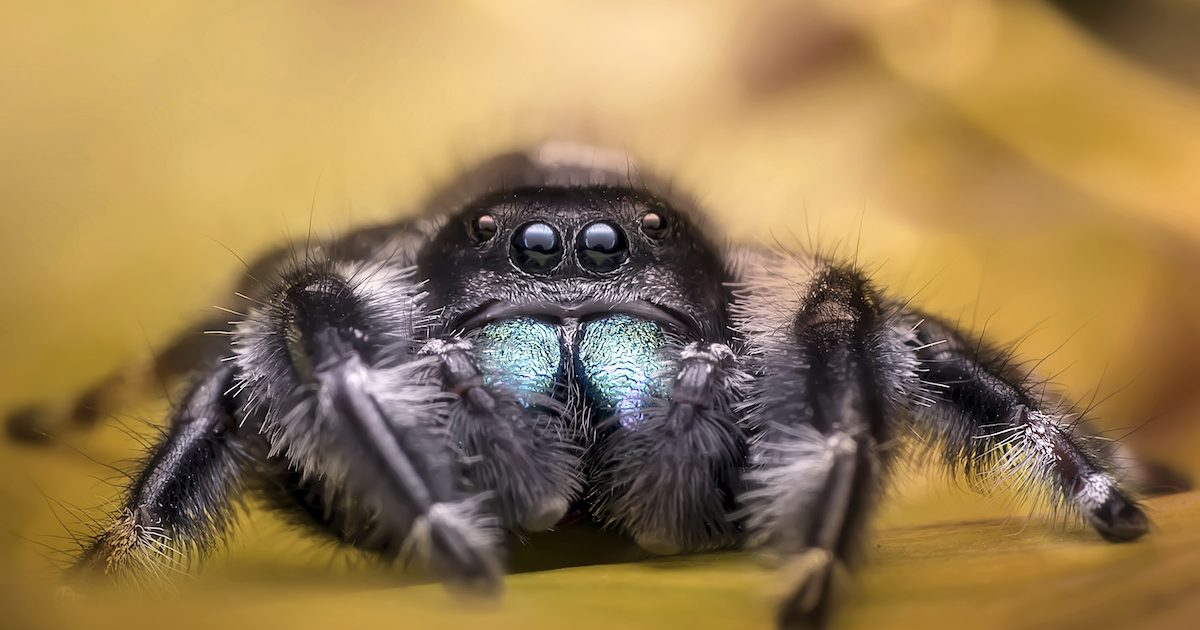
Jumping spiders are a group of spiders that constitute the family Salticidae. As of 2019, this family contained over 600 described genera and over 6000 described species, making it the largest family of spiders at 13% of all species.
Here we go over everything you need to know about jumping spiders.
Some Interesting Facts About Jumping Spiders
Jumping spiders are among the easiest to distinguish from similar spider families because of the shape of the cephalothorax and their eye patterns. Jumping spiders are generally recognized by their eye pattern. All jumping spiders have four pairs of eyes, with the anterior median pair being particularly large. Salticidae male anterior and dorsal aspects, showing positions of eyes.
Jumping spiders have some of the best vision among arthropods and use it in courtship, hunting, and navigation.
Their front four legs generally are larger than the hind four, but not as dramatically so as those of the crab spiders, nor are they held in the outstretched-arms attitude characteristic of the Thomisidae.
The generally larger front legs are used partly to assist in grasping prey, and in some species, the front legs and pedipalps are used in species-recognition signaling.
The jumping spiders, unlike the other families, have faces that are roughly rectangular surfaces perpendicular to their direction of motion. In effect, this means that their forward-looking, anterior eyes are on “flat faces”, as shown in the photographs.
Most diagnostics is the front row of four eyes, in which the anterior median pair are more dramatically prominent than any other spider eyes apart from the posterior median eyes of the Deinopidae.
How Jumping Spider Eyes Are Different
There is, however, a radical functional difference between the major (AME) eyes of Salticidae and the major (PME) eyes of the Deinopidae; the large posterior eyes of Deinopidae are adapted mainly to vision in dim light, whereas the large anterior eyes of Salticidae are adapted to the detailed, three-dimensional vision for purposes of estimating the range, direction, and nature of potential prey, permitting the spider to direct its attacking leaps with great precision.
The rear row of four eyes may be described as strongly bent, or as being rearranged into two rows, with two large posterior lateral eyes being the furthest back. They serve for lateral vision. The posterior median eyes also have been shifted out laterally, almost as far as the posterior lateral eyes.
While unable to form images, the reduced pair of eyes is thought to have a role similar to that of insect ocelli by receiving light from the sky. The photoreceptors in the other secondary pairs are almost exclusively green-sensitive, but the PMEs have two visual pigments different from those in all the other eyes, sensitive to blue and UV light.
Jumping Spiders Have a Near 360 Degree View of The World
Combined with the other eyes, PLEs give the spider a near 360° view of the world. The anterior lateral eyes (ALEs) have the best visual acuity of the secondary eyes. They are able to distinguish some details, as well, and without them, no “looming response” can be triggered by motion.
The anterior median eyes (AMEs) have very good vision. This pair of eyes is built like a telescopic tube with a corneal lens in the front and a second lens in the back that focus images onto a four-layered retina, a narrow, boomerang-shaped strip oriented vertically. Physiological experiments have shown they may have up to four different kinds of receptor cells, with different absorption spectra, giving them the possibility of tetrachromatic color vision, with sensitivity extending into the ultraviolet (UV) range.
Jumping Spiders See Color Differently Than Us
Of the four photoreceptor layers in the retina, the two closest to the surface contain UV-sensitive pigments, while the two deepest contain green-sensitive pigments. The incoming green light is only focused on the deepest layer, while the other one receives defocused or fuzzy images. By measuring the amount of defocus from the fuzzy layer, calculating the distance to the objects in front of them is possible.
All salticids, regardless of whether they have two, three, or four kinds of color receptors, seemingly are highly sensitive to UV light. Some species (for example, ) are highly dimorphic in the UV spectrum, suggesting a role in sexual signaling. Color discrimination has been demonstrated in behavioral experiments. The principal, AMEs have high resolution (11 min visual angle), but the field of vision is narrow, from 2 to 5°.
However, the eye can scan objects off the direct axis of vision. As the lens is attached to the carapace, the eye’s scanning movements are restricted to its retina through a complicated pattern of translations and rotations. This dynamic adjustment is a means of compensation for the narrowness of the static field of vision.
How Big Are Jumping Spiders?
The body length of jumping spiders generally ranges from 1 to 25 mm (0. 04–0. 98 in). The largest is Hyllus giganteus.
Where Do They Live?
Jumping spiders live in a variety of habitats.
Tropical forests harbor the most species, but they are also found in temperate forests, scrubland, deserts, intertidal zones, and mountainous regions. This is the species reported to have been collected at the highest elevation, on the slopes of Mount Everest.
Worried about spiders? Learn more about how Drive Bye Exterminators can help by clicking here.






